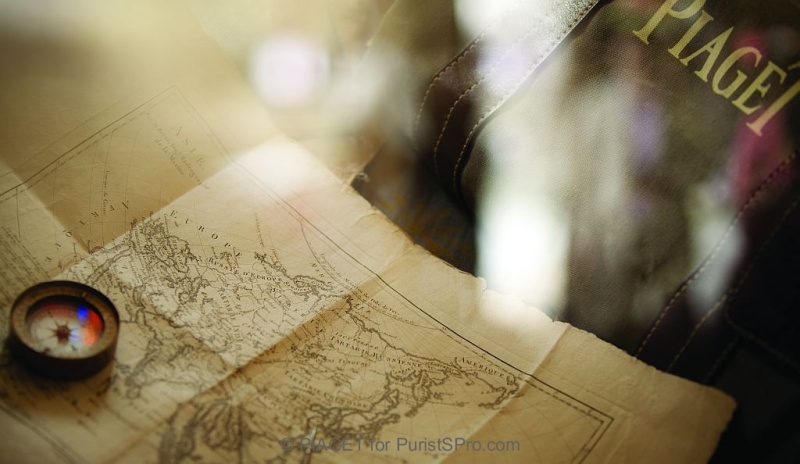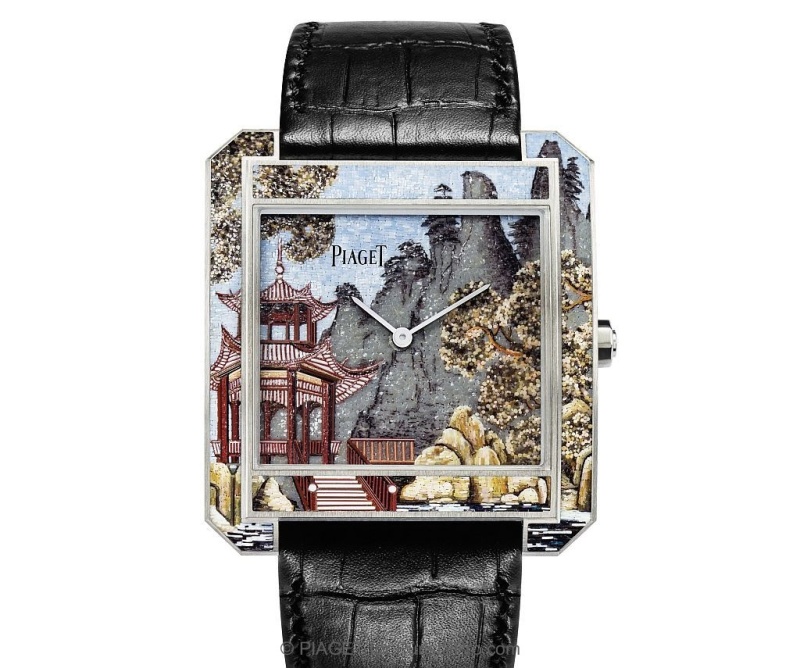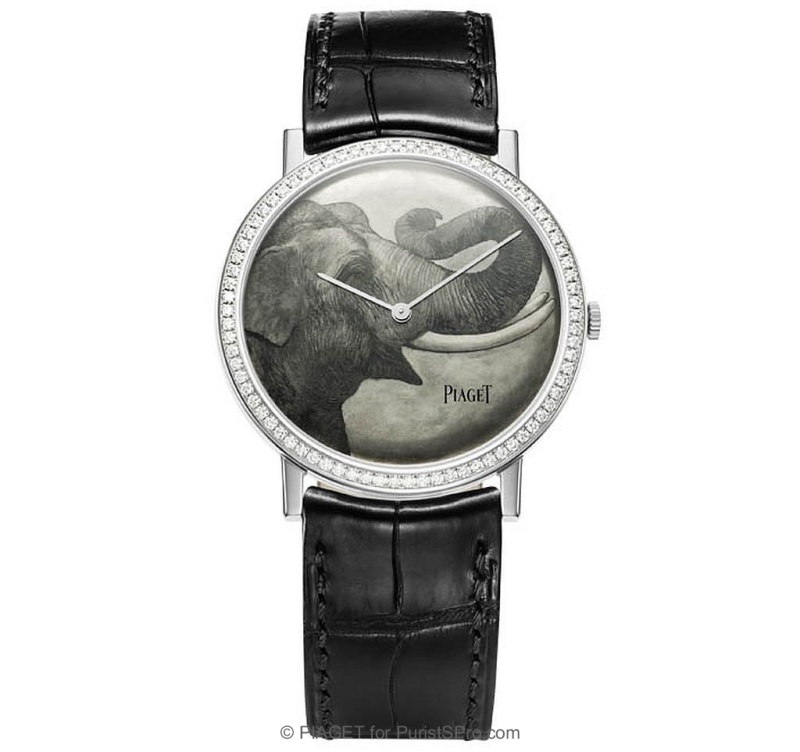
MTF
[PuristS]
13383

A Piaget Mythical Journey Begins (Overview)
A Mythical Journey by Piaget
20 November 2013 - the Journey Begins.
“There are journeys that carry us away and change us for life; journeys from which one returns transformed and of which the memories remain engraved on our minds; journeys full of adventure, discoveries, encounters and unforeseen events…..”
That is how the Piaget press release begins to describe a new Collection of watch and jewellery pieces that astounded me at the sneak preview in September 2013. Sitting on my hands and covering my mouth for two months, we can finally discuss the new Collection.
There is really too much material to go into detail so I propose an overview to whet your appetite today.
Later, we can examine each “technique in the service of aesthetique” for this new Collection that was inspired by both the Silk Route and the Spice Route.

The invitation is to join Piaget in a dream to venture into a poetic world that most of us have read about in stories of exotic beauty, enchantment and passion. In the deep recesses of our psyche, we all yearn for the Escape from reality into the world of Marco Polo, Admiral Zheng He, Sindbad and Ali Baba.
Intertwined with history is the seductive Myth of voyages to discover adventure and passion. We get a glimpse of the epic voyages through Asia and India to Rome...for is it not true that all roads lead to Rome?

The symbolism of the Journey is relevant to Piaget as that was the means to tell the world of the horological wonders hand-made in La Côte-aux-Fées, an obscure Swiss village with more sheep than men.
Gérald Piaget was the first from Manufacture Piaget to travel the world on that new-fangled contraption – the airplane.

Before the modern world of Instagrams and iPads, we could only imagine the distant lands through the exploits and writings of daring explorers to discover things fantastic and unbelievable as described by Marco Polo in his “Travels of Marco Polo”.

Other familiar names were memorised by rote at school. Names that epitomised high adventure and daring journeys: Vasco De Gama, the first European to reach the Indies in 1498 by sailing around the Cape of Good Hope; Hernán Cortés, Amerigo Vespucci, Jacques Cartier, Magellan, and the controversial journeys of Admiral Zheng He in 1421.
The grand voyages that fascinate most are still the Silk Route and the Spice Route.

The first trade routes appeared c.4000 years B.C. They followed the rivers that were the cradles of great civilisations: the Tigris, Euphrates, Nile, Indus, and Huang Ho.
With its new collection, Piaget ventures to travel from East Asia to India and then to Rome, revisiting the days of caravans and camel trains.
A Mythical Journey by Piaget consists of twenty-eight watch models on which micro-mosaic, embroidery, bullino engraving, and enamel work are featured; and eighteen pieces of jewellery created from exceptional stones including emerald and sapphire spheres, facetted sapphires and emeralds, and facetted pink sapphires set in pink gold.
As a prelude to the pieces related to China and India, Piaget is presenting two Emperador Coussin models with dials that illustrate one of two routes from the A Mythical Journey by Piaget collection. The map is an enamel miniature accentuated by hand engraving.

These limited-edition timepieces show the enameller’s talent through absolute attention to detail and his ability. The map is like a painter’s canvas: open to the imagination, the unexpected, the extraordinary. As a tribute to the great explorers in the face of eternity, the dial is decorated with a compass and has a generously-sized moon phase at six o’clock. The eye is drawn to this simple, mysterious lunar orb.

The gem-set bezel accentuates the hypnotic volume and the cushion shape, while the gem-set crown adds just the right note of sophistication.
Imperial Ch’ang-an and the Silk Route
In China, there can be no beauty without harmony. Piaget chose the decorative motifs for the timepieces of A Mythical Journey by Piaget with a deep respect for their meaning and the beliefs attached to them.

The dials of the Protocole XXL and Altiplano Double Jeu models were inspired by a pagoda in the Yunnan region near the Jade Dragon Snow Mountains. These snowy peaks tower over the Lijiang plain.
Fauna and flora are a rich source of powerful symbols in China, being associated with human physical and moral qualities.

Among the creatures of this wonderful bestiary, Piaget was won over by the Ferghana horse with its legendary speed and endurance. This creature is both graceful and ardent.

Piaget was also drawn to cranes, which traditionally symbolise longevity. As legend would have it, they can live a thousand years. As the patriarch of winged creatures and the steed of immortals, the crane embodies wisdom.
Pine trees and flowering-cherry blossoms are the delicate motifs that round out the range of symbols appearing on the dials.

The pine’s persistent foliage and luxuriance even during prolonged periods of glacial cold in winter make it an especially well-beloved tree in China, where its noble character is associated with vitality.

Tender, fragile flowering cherry symbolises spring. This rare species is found in certain parts of China and Asia. A metaphor for renewal and youth, this flower is a favourite subject for artists and poets.



To capture the beauty and timelessness of a motif – a pair of cranes on the Emperador XXL, a pagoda for the Protocole XXL – the master craftsmen took on the delicate task of creating an enamel miniature. The amber tones create a sophisticated harmony to which enamel brings all its depth. The motif appears to be literally brought to life by its sheer intensity.





The Polo Tourbillon Relatif with crane motif is a beauty of the champlevé enamel technique - only 3 pieces made.
The peerless purity of engraving
Other equally prodigious masters of their art are an integral part of the Piaget tradition.
Hand engraving makes it possible to create authentic works of art, whether by means of line engraving, joue slanted-curve etching to achieve a large and progressive cut, or intaglio engraving, a technique that consists in creating volumes by deeply hollowing out the material.

On the Altiplano Double Jeu, the engraving accentuates the virtuosity of the pagoda’s architecture, while the bushy and vigorous pine tree branch stands out with striking precision.
The subtle sheen of white gold, the alternating polished and satin-brushed finishes, as well as the bezel set with brilliant-cut diamonds all surround this Altiplano Double Jeu with an aura of infinitely precious radiance.

Vertiginous diamond setting
The heavenly horse is a powerful aesthetic theme in Chinese art. Reproducing this symbol of natural elevation on a High Jewellery model is a challenge that could only be met by the most talented artisans.

To create this Secret watch, the jeweller finalises the mechanical articulation or hinge connecting the cover to the case. The bracelet is a High Jewellery creation in its own right. Making light of the laws of physics, the diamonds appear to be suspended in mid-air thanks to the extraordinary work of the artisan who fully conceals the claws securing the brilliant-cut diamonds to the body of the horse.

This exceptional and divinely beautiful watch dedicated to the Ferghana horse naturally draws the gaze and thoughts heavenward.

Micromosaic, the art of the infinitely small
In keeping with its creative tradition, the Manufacture Piaget has enlisted the talent of a Roman artisan, a worthy descendant of the 18th century masters. Micromosaics had never previously been used as an ornamental technique in watchmaking.
Juxtaposing tiny tesserae and a polychrome effect creates a stunningly luminous effect. A light blue shade composes a radiant sky in which the clouds appear to be literally floating. A landscape of steep mountains is both dense and majestic. The flamboyant red pagoda is an anthem to good fortune and happiness. The infinitely small exudes an atmosphere of pure joy.

Piaget Limelight Dancing Light
18K white gold case set with 52 brilliant-cut diamonds (approx. 1.6 ct), Mythical Journey logo engraved on the case-back
Black dial, diamond-set white gold rotating plum tree motives

Embroidery, weaving the delicate thread of emotions
Piaget introduces another world-first in the field of watchmaking by using gold thread embroidery to transcend its dials.
On the Altiplano, the pine or cherry tree branch is made using raised satin stitches, a back-stitched filling re-embroidered with straight stitching, while the pine needles are embroidered with straight stitching. This motif calls for over six hours of work and two metres of precious thread.

Dazzling India, heading toward the Eden of the senses
India, the true Eldorado of spices, draws all eyes and heightens every desire.

Colourful decorative crafts for the Spice Route
For the formidably audacious A Mythical Journey by Piaget collection, Piaget dares to present a bold match between gold leaf and enamel. The artisan coats a first layer of enamel, before applying the gold leaf to the dial of the Protocole XXL (not shown), adding a second layer of enamel and proceeding to fire it in the kiln.


On the Altiplano Double Jeu and the Protocole XXL, the Indian temple drawn by the Piaget designers evokes the Lake Palace on the small island of Lake Pichola in Udaipur, India.
Inspired by the Moghul dynasty, this former palace of the Maharaja Jagat Singh II was built facing east to enable prayers at dawn to face the sun god, from which the reigning dynasty of Udaipur claimed to descend.


The animals chosen by Piaget to adorn the Indian dials are the elephant for the Polo Tourbillon Relatif, the Emperador and the Altiplano; and the peacock for the Limelight Exceptional Piece as well as the Altiplano Double Jeu.
In the Hindu religion, Ganesh is a god with an elephant head, capable of removing all obstacles.


Bullino engraving
The so-called “bullino” technique was developed by Italian engravers. It is named after the dedicated tool used by the Italian masters. This engraving, so fine that it can only be done under a microscope, follows a whole series of lines and dots. The effect is achieved according to the varying degrees of pressure applied.

For the very first time, Piaget gives pride of place to this technique in decorating the dial of its Altiplano models with an elephant motif.

The elephant with its sharply defined profile appears in all its splendour. Watchmaking had never previously paid tribute to this noble elephant using the bullino engraving technique – a masterful skill admirably showcased in the new Piaget collection.

The peacock also enjoys distinctive status. With its long neck and its indigo blue breast, it was the crown jewel in the gardens of the maharajas. Krishna honoured it by adorning his headdress with its feathers. A symbol of beauty and dignity, it is now the national animal of India.









The cashmere or paisley motif inspired the jewellery side of the collection. This motif appeared over 2,000 years ago in Ancient Persia.






In the coming weeks, we will embark on this Mythical Journey into every nook and cranny of the horological arts......
Regards,
MTF
"A Mythical Journey by PIAGET" Series (CLICK the following URL links)
A Piaget Mythical Journey Begins (Overview)
piaget.watchprosite.com
PIAGET Mythical Journey part 2: Bulino Engraving
piaget.watchprosite.com
PIAGET Mythical Journey part 3: Plique-à-jour Enamel
piaget.watchprosite.com
PIAGET Mythical Journey part 4: Engraving Gold
piaget.watchprosite.com
PIAGET Mythical Journey part 5: Micro-mosaic
piaget.watchprosite.com
PIAGET Mythical Journey part 6: Precious Thread Embroidery
piaget.watchprosite.com
PIAGET Mythical Journey part 7: Miniature Enamel
piaget.watchprosite.com
PIAGET Mythical Journey part 8: Cloisonné and Champlevé Enamel
piaget.watchprosite.com

A Piaget Mythical Journey Begins (Overview)

OMG! It is not a post! It's fireworks time!

You picked 3 of the best techniques for Mythical Journey by Piaget

Agree on the fireworks

Beautiful pieces of watch art

Piaget's mastery (and Melvyn's superb post) are responsible...
